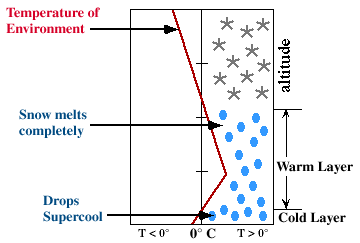|
|
. |
Temperature Profile
for the development of freezing rain
The diagram below shows a typical temperature profile
for freezing rain with
the red line indicating the atmosphere's temperature at any given altitude.
The vertical line in the center of the diagram
is the freezing line.
Temperatures to the left of this line are below freezing,
while temperatures to the right are above freezing.

Freezing rain develops as
falling snow encounters a layer of warm air
deep enough
for the snow to completely melt and become
rain. As the rain continues to fall,
it passes through a thin layer of cold air just above the surface
and cools to a temperature below freezing. However, the drops
themselves do not freeze, a
phenomena called supercooling (or forming "supercooled drops").
When the supercooled drops strike the frozen ground
(power lines, or tree branches),
they instantly freeze, forming a thin film of ice, hence freezing rain.
|
